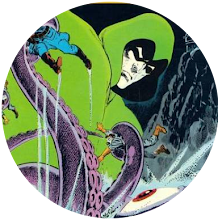And what a masterpiece of compression it is as we get not only the origin of Captain America but also the origin of Bucky, and even their first adventure together, all done and dusted in just nine pages.
Within the origin story there's a strong hint of the problems that'd plague Cap's solo tales of the 1960s, as we get no introduction to Steve Rogers at all. The first we see of him is when he's in the secret, government-funded lab of one Dr Erskine. Rogers is a skinny weakling rejected by the military, for being too puny, but about to drink Erskine's formula that'll turn him into a perfect physical specimen, one of a planned army of super-soldiers ready to take on the Nazi menace. Inevitably a Nazi agent sneaks into the room and shoots Erskine. Now a walking powerhouse, Rogers sorts out the spy, but not in time to save Erskine, meaning Rogers'll be the only super soldier America'll ever have.
 |
| They never did explain what was camp about him. |
We then get a little bit of characterisation as we see Rogers in the army, as a private, acting incompetent in order to disguise his true identity. I assume this idea came from Superman and his Clark Kent alter-ego. The only problem is it means that in our one chance to see what Steve Rogers is like, we're given a fake persona and're still no nearer knowing anything about him than we were at the start of the tale. The truth is that, just as Superman's really Superman, with no true identity beyond that, so Captain America's only himself when he's behind a mask that's meant to be a disguise.
If Steve Rogers is based on Clark Kent then I assume his sidekick Bucky's based on Robin. One night, as Rogers is putting on his costume, ready to smack up yet more Nazis, camp mascot Bucky Barnes blunders into his tent and discovers his secret.
If I were Rogers, I'd show him my fist and tell him to keep his trap shut or else. This may be why they never let me have sidekicks. Cap, on the other hand, is cut from a different cloth - a star-spangled cloth - and so acquits himself far more honourably.
Bucky then carries out his missions under the brilliant pseudonym of "Bucky". Who could ever hope to discover his secret identity when he has that kind of smarts?
It's a story where plot dominates to the cost of all else, which is inevitable given the short page count and the amount of info to pack in but it does an excellent job of it, cramming a whole pile of information into a bite-sized chunk and I really do like Kirby's art here.
So, the hero of the Free World gets off to a promising start but can he keep it up?
I suspect we may be finding out in my very next post.
As long as a Nazi agent doesn't get me first.











































































6 comments:
I always liked that story myself. As you know, kid sidekicks were really only there so that the hero wasn't talking to himself all the time. Either that, or Wertham was onto something with HIS explanation.
"As you know, kid sidekicks were really only there so that the hero wasn't talking to himself all the time"
Not for the young readers to identify with? That was one explanation I read years ago. And I recall an interview in the Comics Journal where Gerry Conway was rabbiting on about the strength of the father/son myth (must have been a truckload of Hollywood producers and directors reading that issue).
I think the 'young readers to identify with' was a later (but still quite early) rationalization, but it never rang true to me. I wanted to be Batman, not Robin and I'm pretty sure that most kids felt the same.
Joe Simon, in his initial sketch of Captain America (I think - might've been somewhere else) wrote something like "We'd better give him a kid sidekick or he'll be talking to himself all the time."
Of course, maybe Robin was introduced for kids to identify with, and Bucky was introduced as a sounding board - both explanations could be true. Still not convinced that the thinking behind the former stands scrutiny 'though.
Incidentally, B SMITH - I think I've managed to track down those photos of Johnny's old premises I took a few years back. Keep your eyes peeeled on my blog over the next week or so.
Does anyone know when the thought balloon was invented? I notice that, in the early Superman stories I've seen, when Supes needs to think things, he just says them out loud to himself.
Don't know for sure when thought and whisper balloons as we know them today became standardized. In the early days, they were just normal balloons with (whisper) or (thinks) prefixing the content.
That's the problem with Cap. He's got no existence beyond his masked, shield slinging persona. Attempts to give Steve Rogers a life outside of Captain America have never worked. That's why I've always loved Captain America - but only when he's in a team book like the Avengers and the Invaders.
Post a Comment